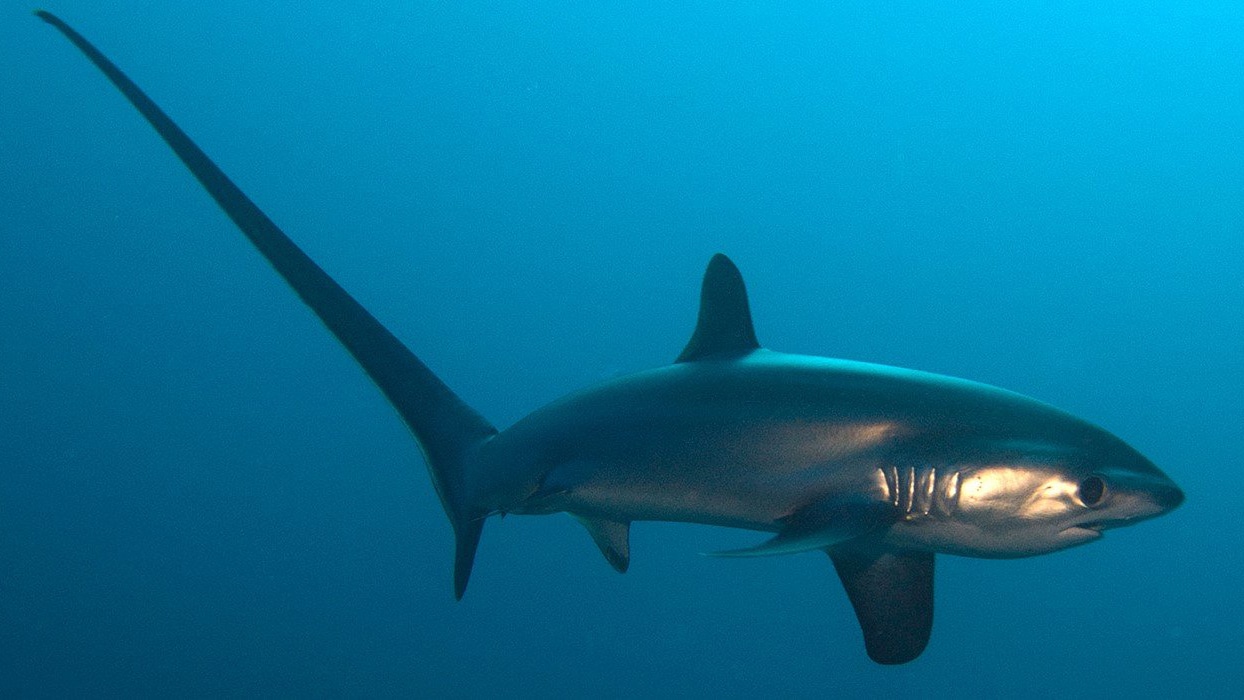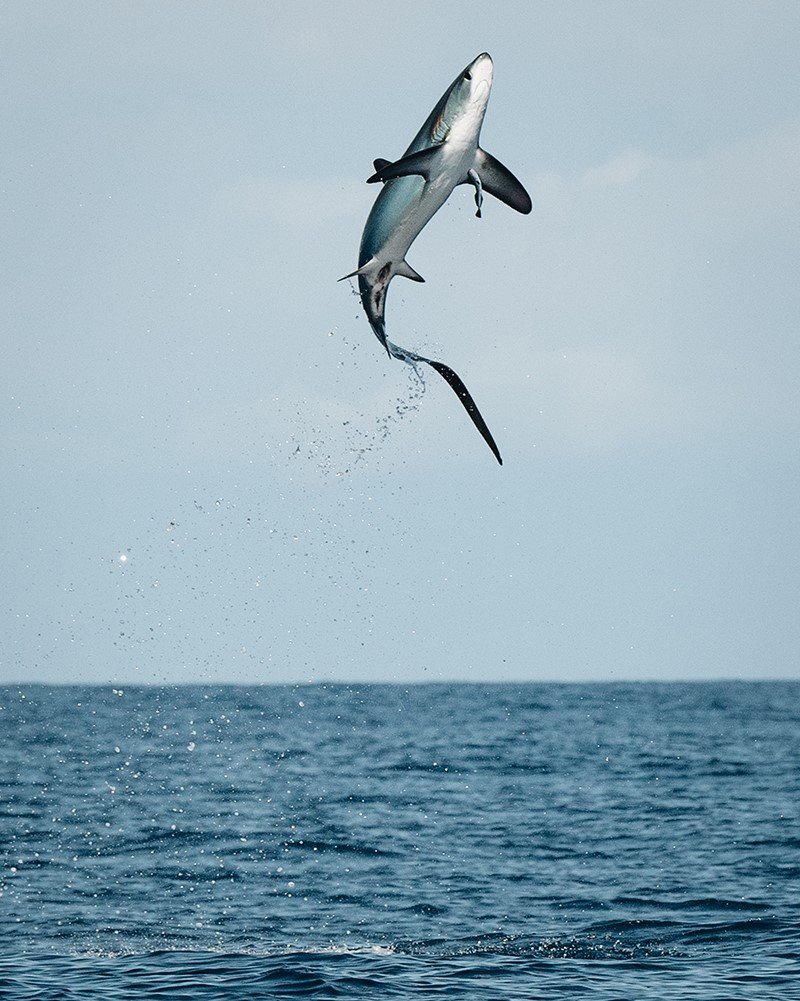Marine Life & Conservation Blogs
Creature Feature: Thresher Sharks

 In this new series, the Shark Trust will be sharing amazing facts about different species of sharks and what you can do to help protect them.
In this new series, the Shark Trust will be sharing amazing facts about different species of sharks and what you can do to help protect them.
This month they’re showcasing the super agile, fish-herding, thresher sharks. Made up of 3 different species, these sharks can whip up dinner at lightning speed…
Thresher Sharks are found in tropical and temperate seas all over the world. Highly migratory, they spend their time in coastal waters as well as the wide-open ocean. By day you’ll likely find them in deep waters, avoiding predators and dining on squid and octopus. But at night, they rise to the surface to hunt small fish.
During daylight hours they may also indulge in a spa. Taking regular trips into shallow coastal waters to visit cleaning stations. Here they get preened and pampered by hungry cleaner fish, who remove pesky parasites picked up during their long travels.
Yet, they are capable of doing this themselves. When cleaner fish are off duty, threshers will remove parasites by breaching out of the water. Check out the photo below – what an incredible sight to see!
To survive in cold deep waters, threshers – like the White Shark and Shortfin Mako – are endothermic. They have a network of tiny blood capillaries, which acts as a heat exchange system. Known as a rete mirabile, this keeps them nice and toasty. In fact, their body temperature can be 10°C warmer than the surrounding water.
But the most distinctive and exciting adaptation of thresher sharks is – of course – their incredibly long, whip-like tail. Shaped like a scythe, this marks impending doom for schooling fish. Making up around half the length of their entire body, their tails can reach up to 3m long! And they’re not just for show…
Hunting in small packs, threshers will use their tail to herd small shoaling fish – such as mackerel, herring and sardines. They’ll then charge into the shoal, thrashing their powerful tail, injuring and stunning their prey. Dazed and confused fish are then swiftly eaten. Larger individuals will also feed on bigger fish, like cod and tuna, as well as large deep-sea squid.
The first part of the thresher sharks’ scientific name is ‘Alopias’, which is Greek for fox. In ancient Greece, the philosopher Aristotle thought these sharks must have been as clever as a fox to avoid the nets and traps of fishermen. But sadly, this isn’t the case today. Due to modern destructive fishing practices, all 3 thresher shark species now face a high risk of extinction.
COMMON THRESHER SHARK:
Bluish to dark grey in colour, the Common Thresher has a pointed snout and small arched mouth.
Depending on the region, females reach maturity between 3 and 13 years. Males between 3 and 8 years. Females will give birth to litters of 2-6 pups in spring/summer, which can be as large as 1.5m! They’re thought to live up to 38 years.
- SCIENTIFIC NAME: Alopias vulpinus
- FAMILY: Alopiidae
- MAXIMUM SIZE: 5.8m
- DIET: Fish and squid.
- DISTRIBUTION: Most tropical and temperate seas around the world. They have a higher tolerance for cold water, than other thresher shark species.
- HABITAT: Coastal waters to the open ocean, from the surface to 650m deep.
- CONSERVATION STATUS: Vulnerable
BIGEYE THRESHER SHARK:
As their name suggests Bigeye Threshers have enormous eyes. These help them navigate and hunt in deep dark waters, and at night. Their eyes can be up to 10cm in diameter and sit within a keyhole-shaped socket, enabling them to rotate their eyes upwards.
Purple to brown-grey in colour, they have the most beautiful metallic hues on their back and flanks.
After a 12-month gestation period, females will give birth to litters of 2 (rarely 4) pups. These can be up to 1.4m long and may live up to 20 years.
- SCIENTIFIC NAME: Alopias pelagicus
- FAMILY: Alopiidae
- MAXIMUM SIZE: 4.8m
- DIET: Fish and squid.
- DISTRIBUTION: Most tropical and temperate seas around the world.
- HABITAT: Coastal waters to the open ocean, from the surface to 500m deep (usually 100m).
- CONSERVATION STATUS: Vulnerable
PELAGIC THRESHER SHARK:
Out of the 3 species, Pelagic Threshers are the smallest and least well-known. Similar in colour to the Bigeye but lighter. They give birth to litters of 2 pups every year and are thought to live around 19 years.
- SCIENTIFIC NAME: Alopias pelagicus
- FAMILY: Alopiidae
- MAXIMUM SIZE: 3.6m
- DIET: Fish and squid.
- DISTRIBUTION: Indo-Pacific Ocean
- HABITAT: Coastal waters to the open ocean, from the surface to 300m deep.
- CONSERVATION STATUS: Endangered
 Discover more with the Thresher Shark Activity Bundle. Brought to you by award-winning outdoor education provider – The Great Out-Tours.
Discover more with the Thresher Shark Activity Bundle. Brought to you by award-winning outdoor education provider – The Great Out-Tours.
Created for children and adults in care homes, these bundles of fun will provide hours of entertainment.
Wordsearches, jigsaws, arts and crafts, educational videos, a family quiz and so much more. All jammed packed into this bundle for just £1, with 15p going to the Shark Trust!
Image banner: Thresher Shark © Matt Newell
Blogs
The Ocean Cleanup Breaks 10,000,000 KG Barrier

The Ocean Cleanup, the global non-profit project, has removed a verified all-time total of ten million kilograms (22 million lbs.) of trash from oceans and rivers around the world – approximately the same weight as the Eiffel Tower.
To complete its mission of ridding the oceans of plastic, The Ocean Cleanup uses a dual strategy: cleaning up the Great Pacific Garbage Patch (GPGP) to remove the plastic already afloat in the oceans, while stopping the flow of plastic from the world’s most polluting rivers.
Through cleaning operations in the GPGP and in rivers in eight countries, the cumulative total of trash removed has now surpassed ten million kilograms. This milestone demonstrates the acceleration of The Ocean Cleanup’s impact, while underlining the astonishing scale of the plastic pollution problem and the need for continued support and action.
While encouraging for the mission, this milestone is only a staging point: millions more tons of plastic still pollute our oceans and The Ocean Cleanup intends to continue learning, improving and innovating to solve this global catastrophe.
This announcement comes as governments from around the world meet to continue negotiations to develop a new legally binding instrument to end plastic pollution at INC4 in Ottawa, Canada. Representatives of The Ocean Cleanup will be in attendance and the organization will be urging decision-makers to collaborate towards a comprehensive and ambitious global treaty which addresses plastic at all stages of its life cycle and in all marine environments worldwide, including in areas beyond national jurisdiction.
It is encouraging to see that the need for remediation is reflected in the various options for potential treaty provisions. It is essential that the final treaty contains clear targets for the remediation of legacy plastic pollution, and reduction of riverine plastic emissions.
Tackling plastic pollution requires innovative and impactful solutions. The treaty should therefore incentivize the innovation ecosystem by fostering innovations that make maximal use of data, technology and scientific knowledge – such as those designed and deployed by The Ocean Cleanup.
‘After many tough years of trial and error, it’s amazing to see our work is starting to pay off – and I am proud of the team who has brought us to this point.’ said Boyan Slat, Founder and CEO of The Ocean Cleanup. ‘While we still have a long way to go, our recent successes fill us with renewed confidence that the oceans can be cleaned.’
The Ocean Cleanup was founded in 2013 and captured its first plastic in 2019, with the first confirmed catch in the GPGP coming soon after the deployment of Interceptor 001 in Jakarta, Indonesia. After surpassing one million kilograms of trash removed in early 2022, the non-profit project has since progressed to the third iteration of its GPGP cleaning solution, known as System 03, and a network of Interceptors currently covering rivers in eight countries, with more deployments set for 2024.
About The Ocean Cleanup
The Ocean Cleanup is an international non-profit organization that develops and scales technologies to rid the world’s oceans of plastic. They aim to achieve this goal through a dual strategy: stemming the inflow via rivers and cleaning up the legacy plastic that has already accumulated in the ocean. For the latter, The Ocean Cleanup develops large-scale systems to efficiently concentrate the plastic for periodic removal. This plastic is tracked and traced through DNV’s chain of custody model to certify claims of origin when recycling it into new products. To curb the tide via rivers, The Ocean Cleanup has developed Interceptor™ solutions to halt and extract riverine plastic before it reaches the ocean. Founded in 2013 by Boyan Slat, The Ocean Cleanup now employs a broadly multi-disciplined team of approximately 140. The foundation is headquartered in Rotterdam, the Netherlands.
For more information, visit: theoceancleanup.com and follow @theoceancleanup on social media.
Marine Life & Conservation Blogs
Creature Feature: Dusky Shark

 In this series, the Shark Trust will be sharing amazing facts about different species of sharks and what you can do to help protect them.
In this series, the Shark Trust will be sharing amazing facts about different species of sharks and what you can do to help protect them.
This month we’re taking a look at the Dusky Shark, a highly migratory species with a particularly slow growth rate and late age at maturity.
Dusky sharks are one of the largest species within the Carcharhinus genus, generally measuring 3 metres total length but able to reach up to 4.2 metres. They are grey to grey-brown on their dorsal side and their fins usually have dusky margins, with the darkest tips on the caudal fin.
Dusky Sharks can often be confused with other species of the Carcharhinus genus, particularly the Galapagos Shark (Carcharhinus galapagensis). They have very similar external morphology, so it can be easier to ID to species level by taking location into account as the two species occupy very different ecological niches – Galapagos Sharks prefer offshore seamounts and islets, whilst duskies prefer continental margins.
Hybridisation:
A 2019 study found that Dusky Sharks are hybridising with Galapagos Sharks on the Eastern Tropical Pacific (Pazmiño et al., 2019). Hybridisation is when an animal breeds with an individual of another species to produce offspring (a hybrid). Hybrids are often infertile, but this study found that the hybrids were able to produce second generation hybrids!
Long distance swimmers:
Dusky sharks are highly mobile species, undertaking long migrations to stay in warm waters throughout the winter. In the Northern Hemisphere, they head towards the poles in the summer and return southwards towards the equator in winter. The longest distance recorded was 2000 nautical miles!
Very slow to mature and reproduce:
The Dusky Shark are both targeted and caught as bycatch globally. We already know that elasmobranchs are inherently slow reproducers which means that they are heavily impacted by overfishing; it takes them so long to recover that they cannot keep up with the rate at which they are being fished. Dusky Sharks are particularly slow to reproduce – females are only ready to start breeding at roughly 20 years old, their gestation periods can last up to 22 months, and they only give birth every two to three years. This makes duskies one of the most vulnerable of all shark species.
The Dusky Shark is now listed on Appendix II of the Convention on the Conservation of Migratory Species (CMS), but further action is required to protect this important species.
Scientific Name: Carcharhinus obscurus
Family: Carcharhinidae
Maximum Size: 420cm (Total Length)
Diet: Bony fishes, cephalopods, can also eat crustaceans, and small sharks, skates and rays
Distribution: Patchy distribution in tropical and warm temperate seas; Atlantic, Indo-Pacific and Mediterranean.
Habitat: Ranges from inshore waters out to the edge of the continental shelf.
Conservation status: Endangered.
For more great shark information and conservation visit the Shark Trust Website
Images: Andy Murch
Diana A. Pazmiño, Lynne van Herderden, Colin A. Simpfendorfer, Claudia Junge, Stephen C. Donnellan, E. Mauricio Hoyos-Padilla, Clinton A.J. Duffy, Charlie Huveneers, Bronwyn M. Gillanders, Paul A. Butcher, Gregory E. Maes. (2019). Introgressive hybridisation between two widespread sharks in the east Pacific region, Molecular Phylogenetics and Evolution 136(119-127), https://doi.org/10.1016/j.ympev.2019.04.013.
-

 News3 months ago
News3 months agoCapturing Critters in Lembeh Underwater Photography Workshop 2024: Event Roundup
-

 Marine Life & Conservation Blogs3 months ago
Marine Life & Conservation Blogs3 months agoCreature Feature: Swell Sharks
-

 Blogs2 months ago
Blogs2 months agoMurex Resorts: Passport to Paradise!
-

 Gear Reviews4 weeks ago
Gear Reviews4 weeks agoGEAR REVIEW – Revolutionising Diving Comfort: The Sharkskin T2 Chillproof Suit
-

 Blogs3 months ago
Blogs3 months agoDiver Discovering Whale Skeletons Beneath Ice Judged World’s Best Underwater Photograph
-

 News3 months ago
News3 months agoPADI Teams Up with Wellness Brand Neuro to Drive Ocean Change and Create a Blue State of Mind
-

 Gear Reviews3 months ago
Gear Reviews3 months agoGear Review: Oceanic+ Dive Housing for iPhone
-

 News3 months ago
News3 months agoWorld’s Best Underwater Photographers Unveil Breathtaking Images at World Shootout 2023




















